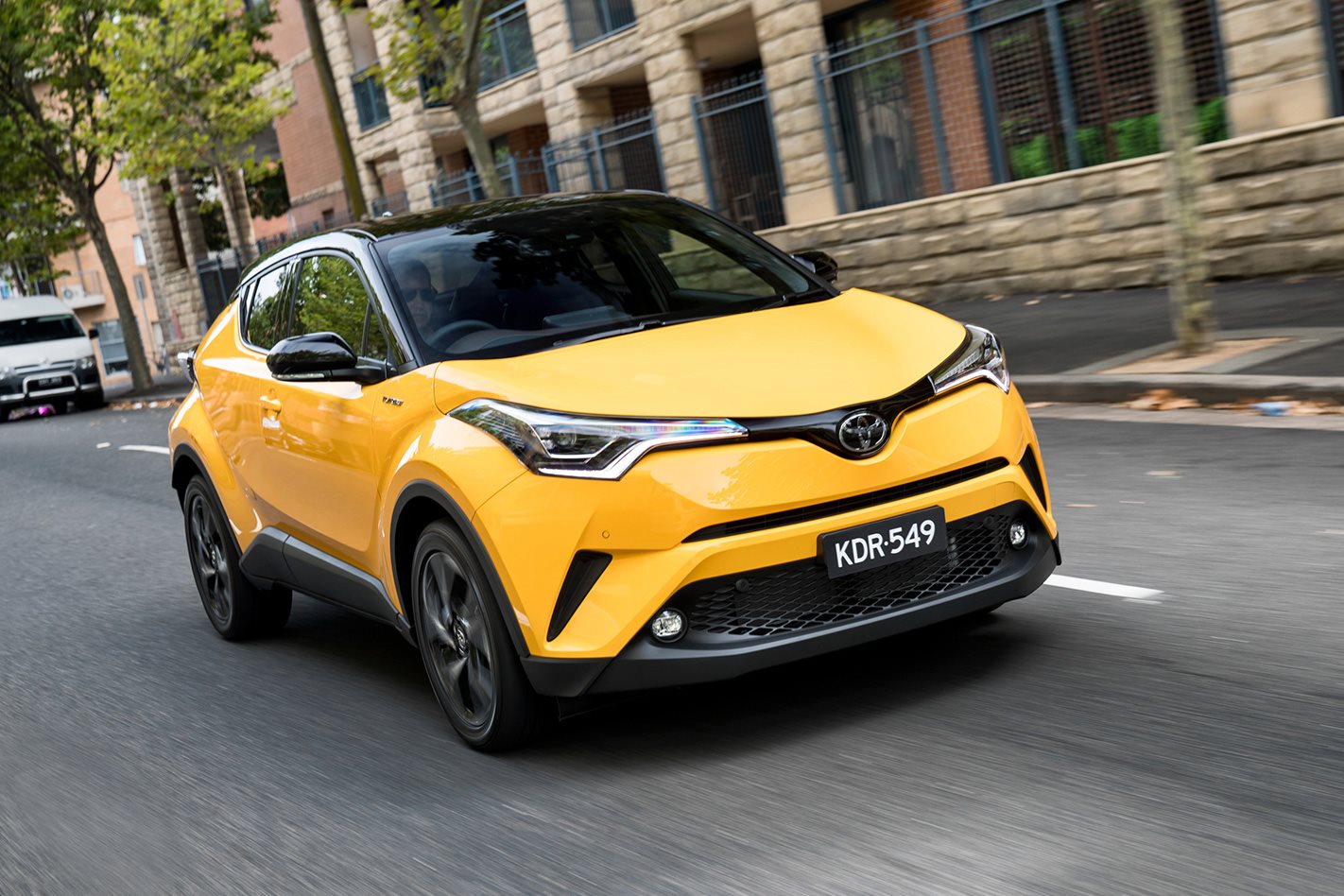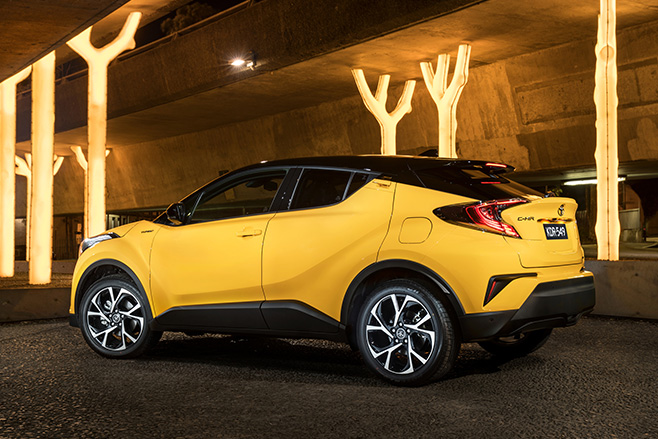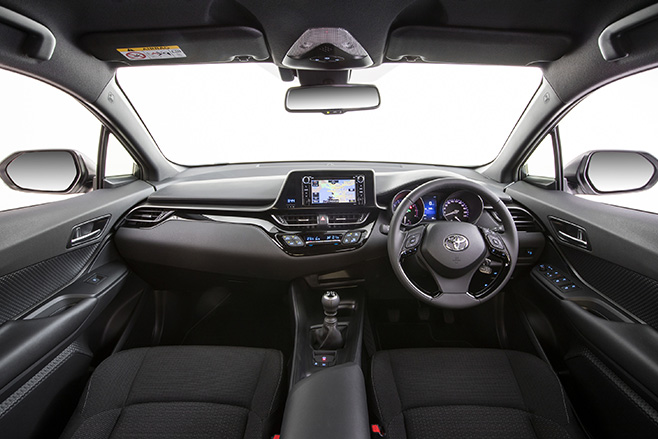
Shoppers looking for a small SUV are spoiled for choice these days. Ever since the Juke burst onto the scene in 2013, there’s been a steadily growing stream of high-riding compact hatches filing into Australian showrooms. The Toyota C-HR is the latest arrival, and after our first experience of it it’s clear that it’s also one of the best in its segment.
Tell me about this car
The C-HR is an all-new model for Toyota and though its exterior dimensions roughly line up with those of the previous-generation RAV4, it’s worlds apart from that car. Sitting beneath the Toyota RAV4 in Toyota’s local SUV lineup it’s the smallest soft-roader on offer by The Big T, while its $26,990 starting price also makes it the most affordable.
That price is higher than most of its segment rivals, namely the Honda HR-V, Mazda CX-3 and Nissan Juke, but is balanced by a generous standard equipment list that actually makes the Toyota a value-packed buy. That’s not the C-HR’s only positive attribute though …

Strengths
1. Willing engine. The C-HR range can only be had with one engine, but it’s a sweet powerplant that boasts exceptional refinement. Making a modest 85kW and 185Nm of peak power and torque, the C-HR’s turbocharged 1.2-litre petrol inline four nevertheless has a strong midrange thanks to a fat torque curve, and is more than adequate for around-town motoring.
2. Handling. Built on Toyota’s new TNGA (that’s Toyota New Generation Architecture) platform, the C-HR benefits from Toyota’s most up-to-date engineering and suspension know-how. With a multi-link rear suspension, the C-HR has a dynamic advantage over most of its rivals, and corners exceptionally well with good body control.
3. Ride comfort. Cars that handle well aren’t always comfortable and vice versa, but the C-HR manages to hit both of those targets. Even on the low-profile tyres of the flagship Koba grade’s 18-inch wheels, ride comfort is great. Bumps are ironed out with ease, and the C-HR feels settled on roads that would have other small SUVs feeling restless (we’re looking at you, Mazda).
4. Eye-catching design. Toyota, long renowned for being synonymous with conservative design, has performed an about-face with the adventurously-styled C-HR. There are creases and crevices everywhere, and while that could easily lead to a design that’s too busy to be appealing, the end result is actually quite easy on the eye.
5. Upmarket interior. The design story is just as strong on the inside, with the C-HR’s cabin trading traditional SUV pragmatism for some visual sparkle. The high console and asymmetrical dash aren’t necessarily sensible, but they certainly look cool. Meanwhile the tombstone-style infotainment screen and higher-than-average material quality also lifts the cabin ambience above the segment standard.

6. Strong equipment levels. Even the in base model, the C-HR packs plenty of gear. From active cruise control, autonomous emergency braking, and satellite navigation to basics like front and rear parking sensors, rain sensing wipers and dual-zone climate control, the C-HR is very well-equipped for its price. To see the full list of standard kit, check out our Toyota C-HR price and features story.
7. Cabin quietness. On the inside, the C-HR is blissfully quiet. While many SUVs tend to suffer from wind noise thanks to their bluff styling, the little Toyota slips through the air a little easier. Other sources of noise, like the tyres, engine and transmission, are also blissfully mute, and the entry-grade C-HR’s 17-inch wheels deliver the best cabin ambience of all.
8. Surprisingly good rear seat space. Look at the C-HR’s body in profile, and you’d assume that those in the back seat would suffer from a tight, cramped rear cabin. The opposite is true. While that’s certainly true of the similarly-shaped Nissan Juke, the C-HR’s back seat is actually surprisingly generous, with plentiful legroom and headroom for two full-grown adult passengers. There are also cupholders integrated into each door and seatback map pockets, though no rear air vents.
Weaknesses
1. Sluggish off the line. The C-HR’s CVT automatic gearbox is fairly slow to respond to sudden demands for more power, and though it’s slightly more alert when the car is placed in Sport mode it’s still quite a soft drivetrain.
2. Rear passenger vision is limited. As spacious as the C-HR’s rear seat accommodation is, it does suffer from a lack of outward vision. The C-HR’s shoulderline, the boundary between its side sheetmetal and its glasshouse, is very high and tapers upward, meaning the rear door glass is incredibly slim. Then there’s the high-mounted door handle, which sits right at the head height of a seated passenger and further obscures outward vision. If you’re a small kid in the back, you’re not going to be seeing much of the outside world during your journey.
3. Kids may have trouble getting into the back as well. The C-HR’s cleverly hidden rear door handle may give it a clean, coupe-like look, but the handle itself is nearly twice as high off the ground as most other doorhandles, meaning small children will need your help when getting into the back – something that family-bound buyers may want to consider.

4. Steering is dull. Yes, we know marking down a car like this down for steering feel may seem a bit cruel, but Toyota is making a lot of noise about the dynamic capabilities of its C-HR and it, generally speaking, does deliver on a great deal of those promises. The steering, however, does not. It’s not terrible, mind you, but there’s not much in the way of feel or feedback and given the chassis and suspension beneath the C-HR is so highly-polished, that’s slightly disappointing.
5. Drinks fancy fuel. You’ll need to budget for more expensive 95-octane petrol with this one, as its direct-injected and turbocharged engine requires higher-quality fuel to run at its best.
6. Boot space. Like many of its segment rivals, the C-HR has a fairly compact boot considering its size. Toyota claims a 377-litre luggage volume with the rear seats up, and that looks about right. However, that’s about par with a regular small hatchback. Bear that in mind if you frequently need to carry lots of cargo.
7. Infotainment upgrades. If you spring for the $33k+ C-HR Koba you’ll gain a number of additional features, but sadly an up-spec infotainment display isn’t one of them. Rather, you’re stuck with the same 6.1-inch colour touchscreen as the base model, while other segment rivals gain a seven-inch – or even eight-inch option.
Anything else I should consider?
Absolutely. The compact SUV segment is becoming more and more crowded with each passing year, and there’s more than a few to choose from. The Mazda CX-3 has established a position of dominance since its launch, while the keenly-priced Mitsubishi ASX offers space and practicality in a zero-frills package. There’s also Honda’s versatile HR-V and the funky (but aging) Nissan Juke to consider, with other options including the Suzuki Vitara, Skoda Yeti, Renault Captur, Holden Trax and Ford EcoSport



